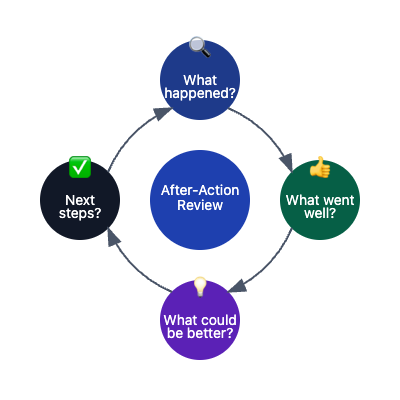After a group works through a conflict, there’s still some important work to do. Even when things end on a good note, people might feel a little uneasy or unsure. Sometimes, feelings linger or routines get shaken up. How the group handles this time right after a disagreement can make a big difference—helping everyone feel stronger and more connected, or leaving small problems that could grow later.
In this lesson, you’ll learn:
- How to help a group rebuild trust and teamwork after a conflict
- Ways to make sure everyone understands what’s changed and what comes next
- How to talk about tough feelings without making things worse
When a group has a disagreement, even if it ends well, people can still feel upset, unsure, or disconnected. It’s easy to think that once the argument is over, everything goes back to normal. But actually, the time right after a conflict is very important. This is when you help the group heal, get clear on what’s next, and make sure everyone feels ready to move forward together.
After a conflict, things can feel a little awkward. People might wonder if things are really okay, or if old problems will come back. The best way to help everyone feel safe again is to be open and honest about what happened and what you learned as a group.
A simple way to do this is by using an After-Action Review (AAR). This is a short group conversation where you talk together about what happened, what went well, what could be better, and what to do next time. The AAR helps everyone feel included and turns the conflict into a learning experience.
You can start by saying something like, “I know our discussion yesterday was tough, but I appreciate how everyone stayed focused on finding a solution. Let’s take a few minutes to talk about how it went, so we can learn and move forward together.”
Then, guide the group through these four questions:
- What happened?
- What went well?
- What could we do differently next time?
- What are our next steps?

For example, you might say, “We all care about doing a good job, and that’s why we had strong opinions. It shows we’re committed to our work.” This helps people see the disagreement as a sign of caring, not a problem.
Be clear about what has changed and what hasn’t. For instance, “We decided to try a new way of sharing updates, but our main goal—helping each other succeed—stays the same.” This helps everyone know where they stand.
Using the After-Action Review makes it easier for everyone to talk honestly, learn from the experience, and feel ready to move forward together.
You can also set up a quick group check-in after a conflict. Ask questions like, “What did we do well during our disagreement?” and “What could we do better next time?” This turns the conflict into a learning moment and helps everyone feel included.
After a conflict, it’s easy for people to feel stuck or unsure about what to do next. The best way to help is to make sure everyone knows exactly what the next steps are.
Instead of saying, “Let’s just do better,” help the group get specific. Ask, “What will each person do differently this week?” or “How will we know if our new plan is working?” For example, if the group decided to change how they share information, you might agree, “We’ll send a short update every Friday.”
Here’s how a conversation might go:
- Nova: I think we need to be clearer about who’s doing what.
- Ryan: Yeah, last time I wasn’t sure if I was supposed to send the report or not.
- Nova: How about we write down everyone’s tasks at the end of each meeting?
- Ryan: That sounds good. I can make a checklist and share it with the group.
Nova and Ryan start with a general problem, confusion about tasks, and work together to make a simple, clear plan. By talking it through and agreeing on the details, they make it easier for everyone to follow through.
It’s also helpful to talk about what to do if things don’t go as planned. For instance, “If someone can’t finish their part, what should they do?” This way, everyone knows what to expect and feels less stressed.
Before you finish, make sure everyone is clear about what’s been decided and what comes next. Go over the plan together and ask each person to say what they’ll do. For example, "Let's check. Lior, what’s your next step? Andrea, how about you?" This helps catch any confusion and makes sure everyone is on the same page.
It’s a good idea to write down the plan and share it with the group, so everyone can look back at it later. Remind the group that it’s normal for plans to change, and it’s okay to adjust as you go. You can say, “Let’s check in next week to see how things are going and make any changes if we need to.”
Helping a group recover after conflict is about being open, making clear plans, and making sure everyone feels included. When you guide your group through these steps, you help turn disagreements into opportunities for learning and teamwork. By practicing these steps, you’ll help your group become stronger and more connected. Up next, you’ll get to try out these skills in a practice scenario.
